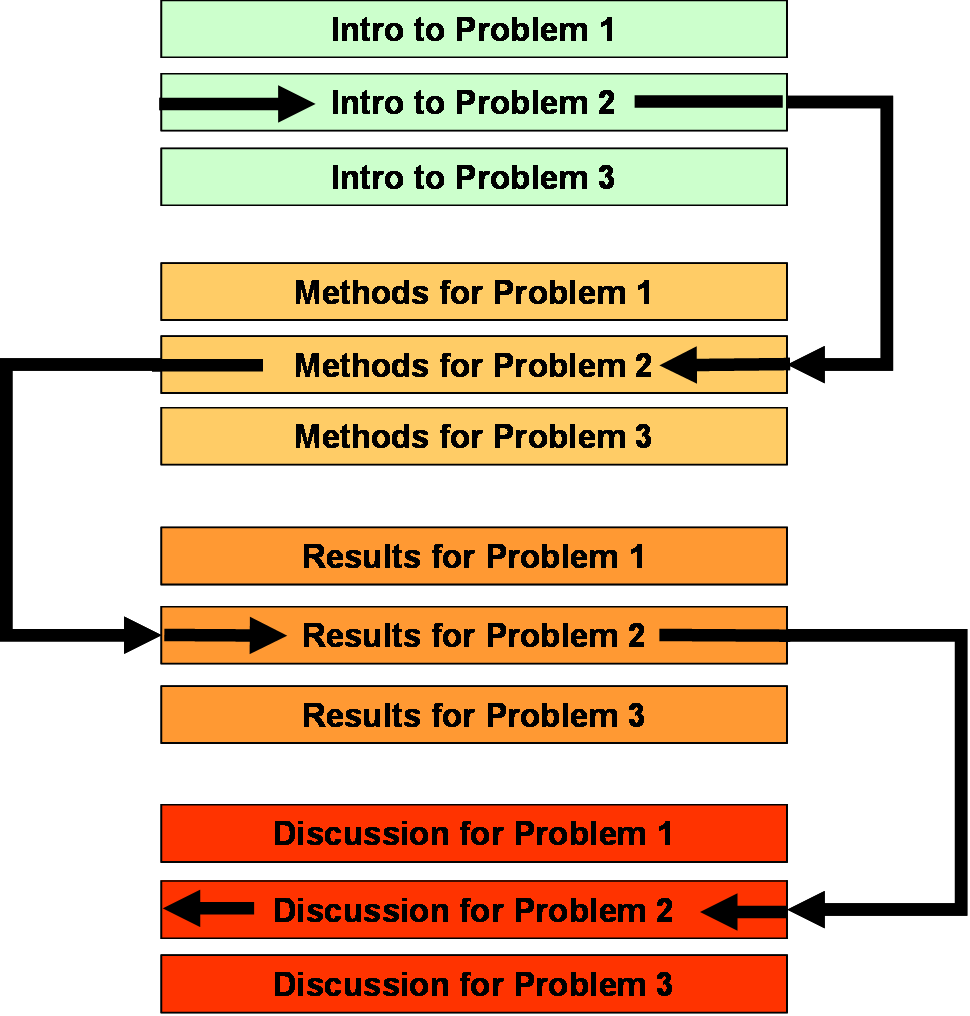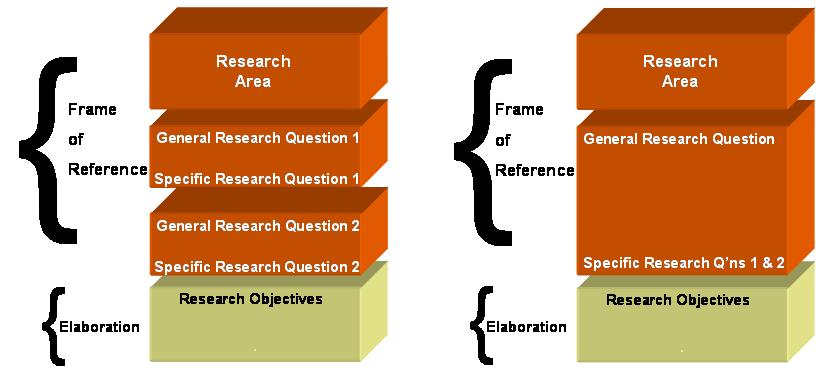The Science Of Scientific Writing Set I The paper as a whole Coherence: The thread problem et al. Exercise 1 Final Page .
OVERVIEW: The way to well-written science
PART I: Paragraphs and Sentences
SET A: Paragraphs: The Maps Behind Them
SET B: Paragraphs: Using Maps to Meet Readers' Expectations
SET C: Paragraph Coherence and Cohesion
SET D: Sentences
SET E: Scientific Sections (including Methods)
SET F: Scientific Sections: The Discussion
SET G : Scientific Sections: The Introduction
SET H : The Paper as a Whole
The thread problem and other aspects of coherence
On the previous page, the cases considered were of papers with a single Specific Research Question (SRQ). Sometimes, a paper will address a number of SRQs, and this presents extra challenges for maintaining coherence. In Set E I suggested that the more "natural" way to organise a multi-question paper would be like this:

This structure is in fact one of the common patterns used for a research thesis (e.g. see Structure 2 in this set of guidelines from this site). However, a research article cannot be written like this, there can be only one instance of each Section type. Therefore the problem arises of how to prevent the reader from becoming confused about the various "threads". As they read the paper, they must remain clear about which problem is being dealt with at each point. This problem faced by any one thread is depicted in the diagram below:

Actually the "thread problem" can be even more difficult, because often, even though the problems may be distinct, the methods and results that are pertinent to them may overlap. However, the expectations of coherence that readers have for these sections are not as high as for the Introduction and Discussion, so here I will only consider how to address this issue in those sections.
In the Introduction, depending on how closely related the problems are, one might adopt one of the following structures (each block represents a separate paragraph):

If you are using the first of these two structures, you need to keep in mind that the initial expectation of the reader is that there will be ONE problem per paper. Thus you will need to explicitly state that your paper is addressing, in this case, two problems. Otherwise:
(1) if the reader is reading in linear fashion, after paragraph two they will be frustrated when they are immediately confronted by a whole new line of thinking about problems (rather than how you went about solving the problem raised in paragraph two). Thus, SRQ1 needs to be couched something like this:
"This led us to consider the first of the two questions addressed in this paper:........"
(2) if the reader is skim-reading the Introduction, they may first identify the "objectives" paragraph (by its distinctive language style, e.g "In this study...") then skip back to the end of the paragraph immediately above it (in this case, paragraph three). Here of course they will find a question, but they also need to know it is only part of the puzzle. Thus SRQ2 needs to be couched something like this:
"This led us to consider the second of the two questions addressed in this paper:........"
It is rather like sending a multi-page fax: you should always mark each page with, for example, "Page 1 of 3", "Page 2 of 3", etc.
In the Discussion, again you need to be explicit, in two ways:
(1) In the Frame of Reference paragraph, start it off something like this:
"In this paper we had two aims...."
and as the paragraph develops, continue the explicit distinctions by starting the appropriate sentences with words like "First,..", and "Second,.."
(2) In the main body of the Discussion section, separate out the discussion of each problem, and use sub-headings to reinforce the distinction for the reader. In the Methods and Results sections, if the various problems share a lot of overlapping content, it is not appropriate to keep the threads entirely separate, since this will result in considerable repetition. But in the Discussion you must, more than anything else, argue clearly, so any concerns about repetition are of only minor significance.
Maximising thread continuity between the Introduction and Discussion
Having distinguished the various threads within the Introduction and Discussion is a crucial first step, but you can improve things if you now double-check that you talk about the problems in the same way in both sections. Given that the draft of Introduction might be written weeks or months after the Discussion is complete, writers often drift into thinking or talking about the problems in slightly different ways, for example under the influence of novel terminology used in a new review they have only just read. This can be extremely disconcerting for a reader, especially those who attack the paper using the skimming approach. You need to look to those locations in the paper where readers expect the problems/solution to be explicitly stated and make sure the the terminology and phrasing is similar. These locations are:
(1) The statement of the Specific Research Question/s in the Introduction
(2) The first (Frame of Reference) paragraph of the Discussion
(3) The sub-headings of the Discussion
To this list we can also add:
(4) The Title
(5) The Abstract
These last two parts of the paper are of course most important for their roles in database searching, but, from a writing point of view, they must also mesh with the rest of the paper. The problem mentioned above, of writers adopting different terminology in the Introduction, is often even more prominent when people come to write the Abstract. This is possibly because people have often been taught in school to avoid using the same terms over and over, and the Abstract often feels the most repetitive part of the paper overall (for the writer that is). Avoiding repetition may be a wise approach in creative writing, but not in technical writing! Readers, especially those who skim, utilise repeated words and phrases to help them navigate the paper. You must help, not hinder, them.
The problem-solution axis: the backbone of a paper
As alluded to above, the reader's initial expectation is that a paper will address a single problem. Therefore if your paper addresses multiple problems, it pays to choose one as as being the most important, and then make this distinction clear to the reader. You can do this by making it the focus of the title, by using explicit language in the Introduction and Discussion ("Most importantly..," etc.), and by devoting more of the paper's "real estate" (inches of text) to the problem and its solution.
Thus in all cases the reader should be able to discern a single problem-solution axis within the paper. And just as an animal only has a single backbone, so should a paper. A single problem-solution axis in a paper also means the essence of the paper will have a strong overlap with the structure of a typical story. Stories rely on the tension as to whether a conflict introduced early in the piece will ever be resolved (e.g. Will love/truth/justice prevail?).
When the problems become too different
Sometimes when you are writing a paper, two threads may develop an "incompatability" which makes them uneasy bedfellows. The most common case is when one thread is theoretical and the other methodological. Giving each the depth of coverage they deserve may then become tricky, and you also have to take into account that in terms of their potentially different target audiences, you may be diluting the impact of each story by presenting them together. This is most clearly the case if you feel torn between publishing the paper in a theoretical or methodological journal. Such a conflict will also make it difficult to establish a strong axis for the paper. One easy solution is of course to publish two papers instead of one!
......